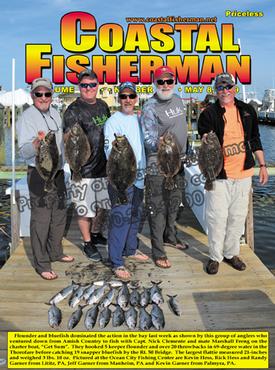


Article by Larry Jock
 What is the most common mistake you see anglers make when they are fishing for flounder?
What is the most common mistake you see anglers make when they are fishing for flounder?
R. Weber, Annapolis, MD
Capt. Nick Clemente, “Get Sum Charters”: The most common mistake I witness on my boat is that the angler feels like they have to really yank on the rod to set the hook when flounder fishing.
Sometimes, flounder are aggressive when hitting the bait, but most of the time you really need to take your time and let the fish get the bait in it’s mouth. This might take some time, so you need to be patient and resist the temptation to set the hook fast and hard.
When we flounder fish on the “Get Sum” we use a double jig head tipped with white Gulp Swimming Mullet. I tell my anglers that when they feel the flounder take the bait, just slowly lift the rod tip up, hold it high for a second or two and start reeling. There is no need to set the hook like you would on a tuna. All you will do is yank the bait right out of it’s mouth.
When you are live baiting for flounder, it is even more important to take the time to feed the bait back to the fish and let them get it completely into their mouth.
The hook setting process also depends on the size of the bait. If it is only a minnow, you can just drop your rod tip and then lift up to set the hook. If it is a larger bait, like spot, you need to give the flounder more time to eat it. Sometimes, you even need to free spool the bait so it gives the fish even more time to get it in their mouth before you set the hook.
Another common mistake I see is that when an angler brings their own tied rigs. They tend to use heavier line and larger hooks than necessary.
When flounder fishing , do you have different strategies depending on the tide?
A. Miller, Ocean City, MD
Capt. Nick Clemente, “Get Sum Charters”: When it comes to fishing the tides, the main thing I consider is the effect it is having on water temperature and clarity. These are two main factors in successful flounder fishing.
This time of year, the flounder are looking for warmer water so we like to fish the outgoing tide where the water has had time to warm up, especially in the shallows. That is why you see a lot of anglers finding good bites in the Thorofare this time of year. The water on the flats can get shallow at the end of the outgoing tide. This shallow water, along with the water dumping out from the upper bay tends to be warmer than what you find elsewhere.
During the summer, when the entire bay seems to be like a warm bath, flounder feed better when they are in cooler water, so we like to fish the incoming tide. This tends to bring cooler water into the bay. It’s also a good time to look for deeper holes where the water can be much cooler than what you find on the surface.
The tides also have a big effect on water clarity. We are looking for the greener water in the bay as opposed to the browner water we sometimes see after storms or a lot of wind.
Since flounder are sight feeders, water clarity is a key to success. For example, if the water in the bay is brown, but an incoming tide is bringing in cleaner water, I will adjust my plans so I can fish closer to the Inlet. I won’t head to the Thorofare or down behind Assateague. Some days you can literally see the line separating the clean incoming water from the browner water already in the bay.
For flounder, what color artificial baits and lures do you like to use?
M. Hackney, Milford, DE
Capt. Nick Clemente, “Get Sum Charters”: When it comes to artificial baits, I really love Gulp products. I have been fishing them for several years and they really produce. They revolutionized the fishing industry when they came out with artificial baits that are impregnated with scent.
Most of the season, my “go to” bait in the bay is the white, 4-inch Swimming Mullet, which is nothing more than a curl tail. We like to rig them up on red, white or chartreuse jig heads. We mix them up to see what color is working best on that specific day because everyday can be different.
If I head to the ocean for some flounder fishing, I may go with a larger Gulp bait that measures 5 or 6-inches and rig them on bucktails or jig heads.
In the spring, we may give pink or chartreuse Gulp baits a try. These colors will sometimes work better at that time of year, but we always seem to switch to white Gulp baits as the season heats up.